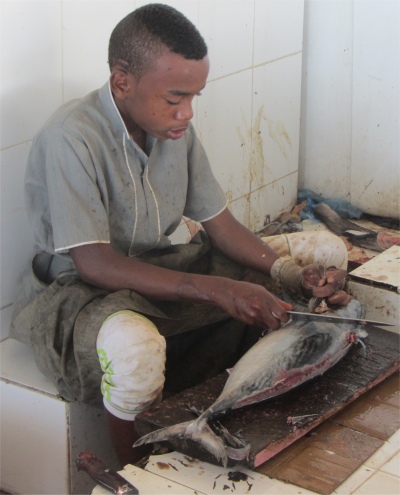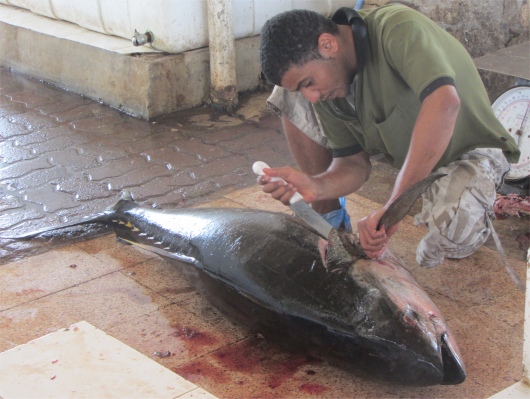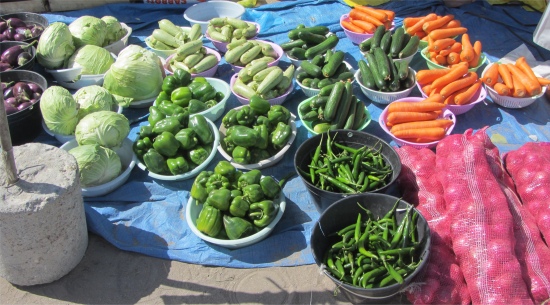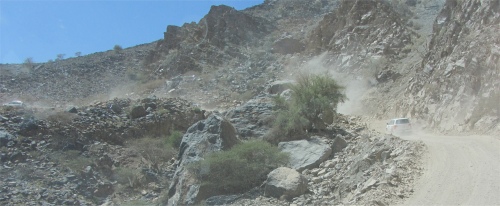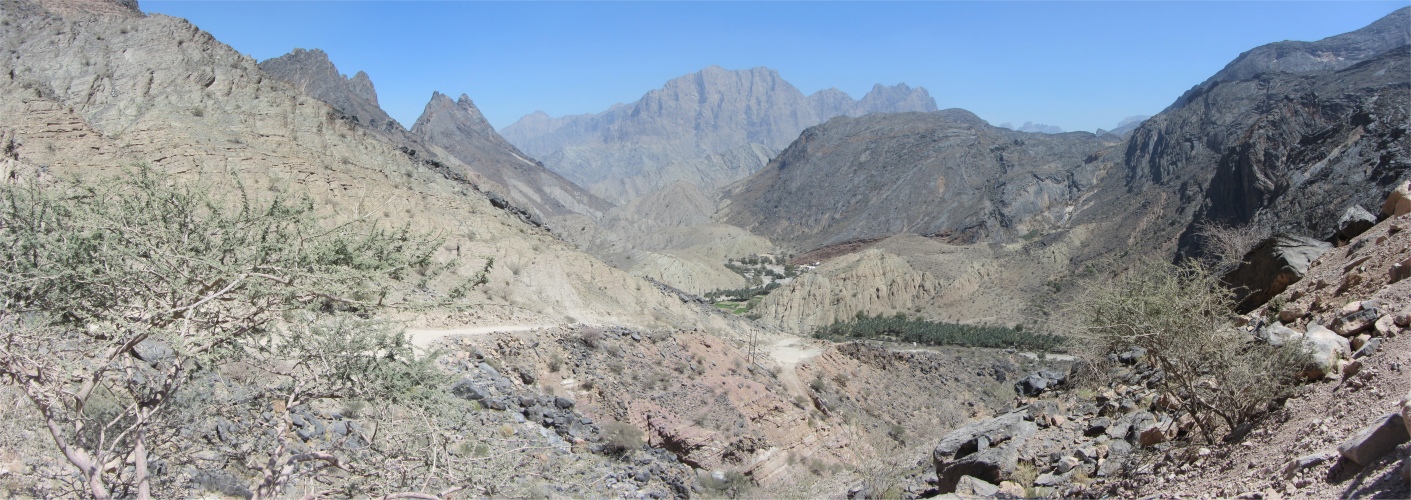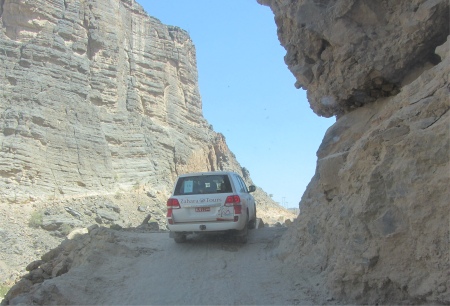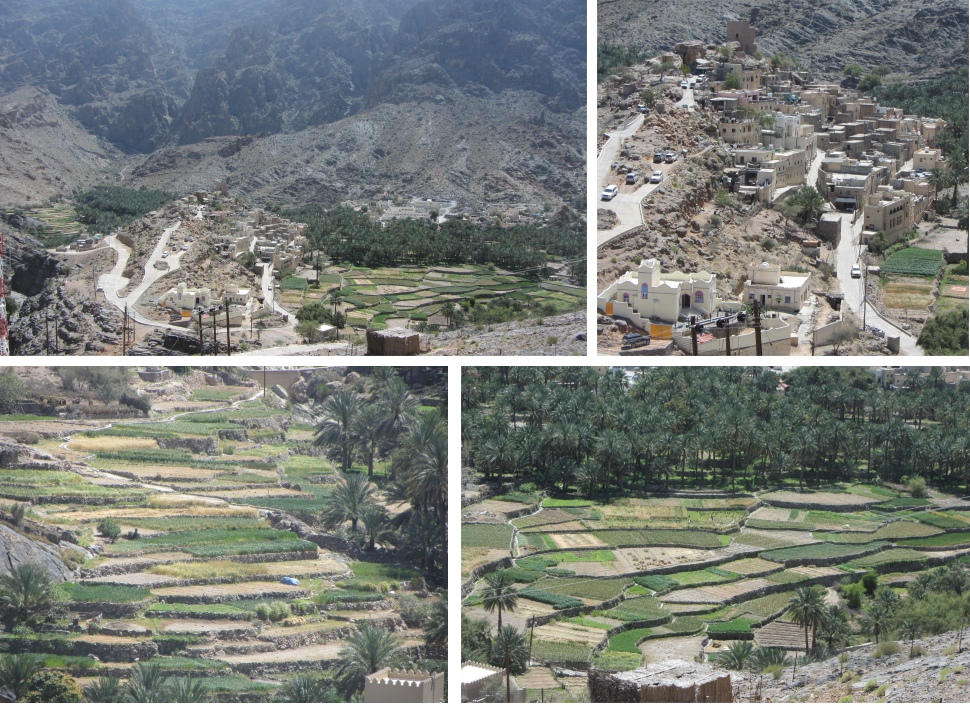
Bilad Sayt
|
Vegetation was verdant for several kilometres along one side of the wadi, following the course of a perennially flowing
falaj. Tucked away in the cool confines of this growth were the houses of local residents, shielded from the glare of the sun. We passed the small village of Zammah, and then moved on to serious hill climbing. The track was now only wide enough for a single vehicle, with passing places strategically placed along the trail. The road quickly gained altitude on a steep and dusty track, clinging desperately to the tall wall face of the wadi. The track had literally been hacked out of the mountain faces, and much climbing and descending was involved as we traversed deep ravines. The colossal mountains that crowded in on us dwarfed the trail and vehicles on it. Twisted strata told of a tale of pained torment in their formation over 600M years ago. Geologically, they were fascinating, ranging from black volcanic basalt to grey sedimentary slates.

Goat Herders
|
We caught up with a convoy of 4x4s laden with groups of adventurous folk from the cruise ships at Mutrah.
The final pitch of our climb made
New Zealand's Skippers Canyon look like a country stroll. Then, all of a sudden, we were presented with a most spectacular view. Stretched out far below was Bilad Sayt, a tranquil mountain hamlet tucked away in the protective embrace of Al Rostaq's rugged hills, with its cluster of stone-and-mud dwellings laid out like steps along the slope of a rocky hill. A labyrinth of narrow pathways connected these atmospheric dwellings, some of which were even two or three storeys high. A formidable square tower, now in poignant ruin, stood on top of the hill overlooking Bilad Sayt. The village seemed to retain traditional charm and a sense of rural solitude.
A verdant swathe of date palms and a patchwork of lush, terraced fields accentuated the scenic beauty of this natural setting. All around were the impressive profiles of mountains that were a part of the Jebel Shams range. From somewhere deep within these mountains, crystal streams of water emerged that eventually fed the village's two main falajs. These nurtured the area's lush heritage of date palm gardens and farms below. The overflow ended up in the wadi that skirted Bilad Sayt and meandered on for about 7km, cutting a deep swathe through the surrounding mountains. We didn't proceed down into the village out of respect for the residents' wishes to keep their paradise tourist free.
Up an offshoot wadi, a track could be seen snaking up high over a far off ridge. The trail would eventually reach Nizwa, which I would be visiting tomorrow from a different direction.
Once I'd had my fill of the splendour of Bilad Sayt, we retraced our steps, spotting an eagle soaring effortlessly over the flanks of a lofty crag.
Lower down on our return, we pulled off to stop by a feeder wadi. We walked past a stretch of date palms fed by a dried up
falaj, and into a tall, narrow gorge. The immediate coolness was striking and very refreshing, indeed a cool breeze actually flowed through the gaping chasm. Approaching us was a herd of goats driven by three young goat herders, followed by sun's rays slanting through the clouds of dust kicked up.

Ath-Thowra Hot Springs
|
Venturing forth, the gorge opened out enough to allow sunlight to lay down dappled patterns on the ground. Light and shade shared the landscape between them. Massive, smooth boulders and rocks strewn along the wadi bed held evidence of the wrath of furious floodwater action over the ages. Today, there was a trickle of water running through the canyon, and we encountered small pools as we gained height. I was totally surprised to find small fish and even a frog in these pools; an indicator that the pools never completely dried out.
Time was pressing, so we sadly had to curtail our exploration and move on, leaving the wadi behind us. Pulling in to a small settlement, a hungry Issa asked, "Do you like Indian food?" "I love Indian food," I replied, adding, "Did you know that England's favourite dish is chicken tika massala?" He found that hard to believe. He mentioned that many Indians had come to Oman to seek work, and in the process had now dominated the cuisine.
He took me into a very small restaurant, where things were lost in translation, but we both ended up ordering chicken biryani. I was courteously invited to wash my hands before the meal, and after it too. Being a Muslim, Issa ate the entire meal using his right hand, and declined cutlery. Practice makes perfect I guess.
Rejuvenated, we were soon headed to Nakhal (palm), a picturesque town butted on to the Hajar Mountains. Our first port of call here was the hot springs at Ath-Thowra. Issa managed to find a space in a very congested car park situated next to a pretty stream of water. Children played and splashed in the sun-dappled water, while ever watchful mothers sat in the shade under the date palms, gossiping and serving up food to tiny tots. Vehicles that had been up in the mountains were covered in dust, and enterprising youths were running an impromptu car wash service. We followed the waters upstream until we reached a large bath cut in the rock, in which kids were having a wonderful time leaping into. The bath was fed by a natural spring gushing out of the vertical wadi wall. I felt the emerging water, and it was quite warm. Some of the water was diverted into a falaj. These are common in Oman, and are stone or concrete channels that convey water for the irrigation of surrounding plantations.

Nakhal Fort
|
I had seen falajs further up the wadi, feeding water from natural springs to small hamlets. Such settlements also tended to have wells as backup. Issa explained that the spring water had to be filtered before being drunk, whereas well water was pure. The rich calcium content gave rise to high incidences of gallstones.
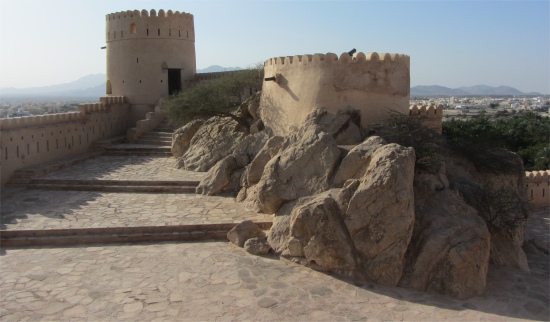
Fort Built on a Hill
|
The Ath-Thowra falajs fed a green oasis, with over 2000 date palms. These trees started bearing fruit after 8-10 years, and would continue to do so for up to a hundred years.
Our final port of call was the dramatic fort of Nakhal, built on the foundations of a pre-Islamic structure. Issa led me up into the fort, paid for my entrance, and then cheekily suggested I tag on to the end of one of the cruise ship tours. I tagged on to a group of English souls who made me feel positively young.
The picture-perfect Nakhal Fort is one of the most prominent historical monuments in the Sultanate, with a backdrop of the jagged peaks of the Jebel Nakhal, a spur of the main Western Hajar range. It derives its name from the Wilaya itself. The fort lies amidst palm orchards in Wilayt Nakhal in Al Batinah South Governorate. It is an entrenched building that rises above a rocky hill at the base of Mount Nakhal in the northeast of Al Jabal Al Akhdar (Green Mountain). The fort had been constructed around the high rock during the reign of Imam Said bin Sultan in 1834.
Our guide took us into various rooms containing a multitude of artefacts. Small shields, made from the hides of rhino and hippos, hung on walls, and incense burners took pride of place on the floors. The Wali's Room, a large chamber with colourful cushions placed around the edges of the carpeted floor, would have been used to receive other Imam or people of authority. Copies of the Quran were always kept in the Boy's and Girl's rooms, which were all modestly furnished with old rugs, crockery and fine old wooden chests, plus a couple of antique (and very rickety) four-poster beds.

Wali's Room
|
Up on the ramparts, splendid views could be had of the Batinal Plain. For defence purposes, round towers had been erected to deflect cannonballs, and spiked doors repelled battering. A small watchtower stood equipped with loopholes just big enough for a rifle barrel, plus wider openings through which (in traditional Omani fashion) boiling date juice or honey could be poured onto attackers below. A very deep well was on hand in the event of a siege.
We left the fort and made the long journey back to Ruwi. We had been away for 9 hours, and had covered over 400km, but it had been well worth it. Conversation fell away, Issa being more interested in his mobile phone, but I thanked him profusely on my return to base.
I ventured down to the hotel bar in the evening to catch up with my notes over a cool beer. A family of Filipinos were providing moral support to the resident band, the drunken eccentric granddad proving to be both a pain and embarrassment to the rest of the family. I hope I never get like that.
I managed to have a chat with the guy who formed one third of the band. I learned that he and the two girls were Filipinos. He was a civil engineer by profession, and loved music, which is why he pulled the band together as a part-time hobby. The two girls had no formal singing training, they were just naturally talented. I complemented him on the quality and the very wide scope of their music.
It had been a long day, I was whacked, and soon I was in the land of nod.
